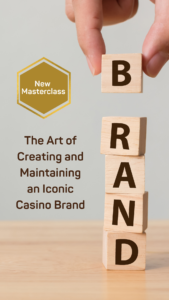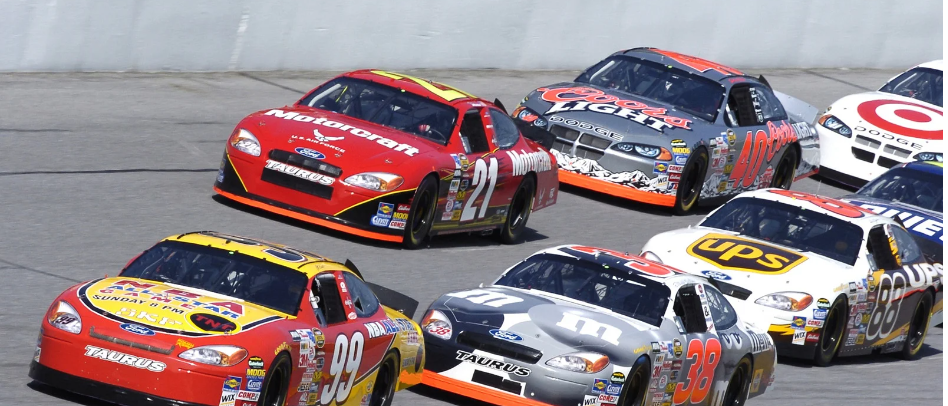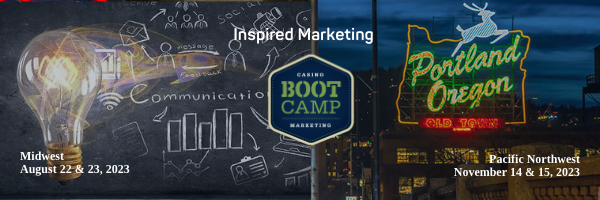I’ve been lucky to have worked in many companies and many territories. And, while I often have the impression that people are most taken by the billboard-worthy work I’ve done in Las Vegas, some of my best work has been done in very small markets where we had to be more creative and innovative – sometimes just to stay competitive.
Many years ago, I was introduced to the notion of a “challenger brand.” Before this, I had worked for some of the leaders in the industry. This time, it was not the case. So, the notion of being the underdog, while new and uncomfortable, was now my reality.
We don’t often look at today’s brands as underdogs, but many started as such and found a way to bring themselves to the top. Do you remember the idea of getting a movie sent to you in the mail? What a crazy idea. There was a Blockbuster a short drive away. Why would you use this new Netflix mail service?
Today, Netflix has put most of those video rental locations out of business. It has also simultaneously become one of the most prolific producers of original programming, garnering an impressive number of Emmy and Oscar nods. Imagine the conversation at any big studio when word started to spread that Netflix would start producing content.
Looking back on the company’s evolution, you’ll find that although they were the underdog for years, it never acted like it. They set out to be the best and the biggest by acting like they already were – with the confidence of a first-place brand. You can do the same. Whether you are a new entry into the market, one that has fallen behind, or one that has welcomed a category-killer competitor, you can take some easy steps to think like a challenger brand and become a market leader.
What is a Challenger Brand?
The concept of the challenger brand was first introduced by Adam Morgan in his book Eating the Big Fish in 1999. At the time, the most common usage was associated with underdogs, but today the focus is more on WHAT the brand is challenging rather than WHO – consider what drives a category or the guest experience.
It is defined by a mindset where an operation might have ambitions to break through the category that might be bigger than its immediate resources, but they are prepared to do something bold that can go against existing conventions.
Brands, both large and small, can often find themselves in the challenger roles.
The idea of being a challenger brand can often be reduced to a shallow concept of David vs. Goliath, but this notion can often block market leaders from the nimble mindset of a challenger. In other words, although what follows could be a playbook for a small operator, large operators can also learn valuable lessons. Moreover, given the shift in consumer habits, it could be a valuable strategy for us all.
Importance of a Challenger Strategy in the Casino Industry
For smaller casinos, taking on a challenger mindset can be essential in standing out among the competition. This strategy harnesses the idea of ‘eating the big fish’ by identifying ways to leverage competitive advantages they may not even be aware of and turning a smaller entity into a powerhouse. It also allows them to modernize traditional practices and processes, giving casinos with limited resources an edge in terms of agility that might often bog down larger competitors.
Ultimately, taking on this pioneering attitude can help level the playing field for smaller casinos, allowing those who take it seriously to break away from the competition and come out ahead.
Of course, this doesn’t come without risks. There will always be a certain level of uncertainty when trying something new or taking on larger players, but a well-crafted strategy focused on customer satisfaction can help smaller casinos carve out their place in the industry.
The first step is changing your view from a state of the marketplace to a state of mind, a shift from who you are challenging to WHAT you are challenging. Many brands we see in our lives have found success by shifting the view: Walmart, Nike, Apple, Virgin, Target, Dove and more. Your brand could easily be added to this list.
What Kind of Challenger Are You?
There are ten central types of challenger mindsets. Understanding where you are can provide clarity to your strategy.
- Democratiser brands believe in bringing access to all, particularly what might have been available to an elite audience only.
- Dramatic Disruptors offer something significantly superior to the status quo. Consider how Casper revolutionized the mattress market.
- Enlightened Zaggers deliberately swim against the tide.
- Feisty Underdogs see themselves in a battle between small and big, good and evil, or us and them. Chutzpah is a thing for them.
- Irreverent Maverick brands use wit and humor. They are provocative in their goal to entertain and engage.
- Local Hero brands champion the local needs, local culture and local people through their deep understanding of and presence in the community.
- Missionary brands wear their purpose on their sleeve and are usually focused on righting an existing wrong.
- Next Generation brands might question an entire category believing new times call for new brands.
- Peoples’ Champion brands are driven by mandate. They are agents of change, often creating people-powered alternatives.
- Real and Human brands challenge a certain industrialism in the category and appeal to consumers more emotionally.
You may immediately see yourself in one of these categories, but as I’ve always said, brands are living organisms. Just as we grow and change, so do our brands. While I invite you to see yourself as one of these types of challenger brands, I advise you to review this periodically.
Adopting a Challenger Mindset
None of us can afford to rest on our laurels. Technology is transforming our businesses every single day. More importantly, guest expectations continue to morph. More competitors are reaching their hands into the wallets of our customers. The battle for the entertainment dollar continues to challenge us.
A challenger mindset keeps you focused on the next edge and can keep us from becoming complacent. But there are some great recommendations for developing that mindset.
Get clear on your challenge.
Understand what might be challenging you and what change you’re trying to bring about. For Netflix, it wasn’t merely about getting subscribers to rent from them, it was about changing how people would rent movies. That was a bold ambition indeed. We know, as casino operators, that we can make a splash with new slots, new rooms, new restaurants and more new. However, we now realize our competition is not the next box of slots up the road, it is virtually any way an adult might choose to spend leisure time and dollars.
Your assignment: Ask yourself, “What am I challenging? What bold, ambitious change am I trying to bring about?”
Be intelligently naive.
Consider the many companies that were launched in someone’s garage, like Apple. When you read their history, it is mind-boggling to consider how much they didn’t know about the categories they were entering. Innocence can be unexpectedly beneficial. Jeff Bezos was a hedge fund manager who thought he could sell books online. How can you change how you create opportunities to grow loyalty and revenue?
If you follow the Savannah Bananas, you might know about their owner Jesse Cole (the Yellow Tux Guy) and his over-the-top meetings where employees are encouraged to think with no restrictions. The Bananas are creating a new way to enjoy America’s pastime without the confines of the usual rules. In an odd coincidence, The Challenger Project has put the Bananas on the list of brands to watch in 2023.
Your assignment: Ask yourself, “Can I change the way I ask the central question facing my business?” More importantly, can your team members change their views?
 Steal with pride.
Steal with pride.
I love looking at other industries to see what they are doing right and how I can use the same idea. Method founder Eric Ryan once said, “All the big ideas I could ever need are already out there. I just have to find it and work out how to apply it to my business.” IKEA is an excellent example of applying an idea from outside the industry. Rather than looking at other home furnishing retailers, they considered an entirely different category and overlayed those rules onto their business. One result of this process is their Guggenheim-inspired store layout. Whenever I have workshops, there is usually a point when I ask participants to bring ideas from companies they admire so they can discover how they could apply the concept to improve their marketing.
Your assignment: Have your team bring examples of ideas from other industries to your next meeting and see how you can adapt them to your business. Encourage them to avoid trying to find ideas that easily fit. You want bold, out-of-the-box thinking that will make you stand apart.
Find your religion.
Do you know the old saying, “if you don’t stand for something…”? It’s similar to finding your brand’s religion. What does your brand stand for that is something deep at the core of the brand? What is it that provides clarity, direction and focus on everything that is done? What is it that will draw others to join you?
Simply put: what matters most? Challenger brands build lighthouse identities – a compelling truth that invites customers to navigate BY them and is projected consistently in everything they do, not merely by a tagline.
Zappos created a company that no one could’ve seen coming, removing the friction from buying shoes by making it easy to shop, easy to return and easy to get assistance. Today, we see more businesses guiding themselves by the Zappos ethos.
This might be the trickiest of the mindsets for some operations because they may not have had the time to codify their “religion.
Your assignment: As yourself these questions. What do you believe in as a business, and how do you behave in support of your beliefs? What do you offer as a consequence? What are you trying to change? When you closed your doors during COVID, what was missing from everyone’s life (other than a paycheck) or, better still, what held so true that no matter what happened, that one thing was never going to change?
Get noticed and be famous.
Challenger brands will project their beliefs consistently (and almost insistently) in everything they do. You notice them even if you’re not looking for them. If you think it takes a lot to level the playing field, imagine how much more you need to invest to puncture inertia. The greatest danger for a challenger brand is not rejection. It’s indifference!
Most of the readers of this blog travel at least once or twice a year on business and perhaps a few more times for pleasure. For most, it’s not an experience to write home about. When a new player enters the ranks of airlines, they may publish a press release and get a local news story if their airport partner creates an “event.” We might give them a look if only to check routes and rates.
Now consider the launch of Virgin’s inaugural flight from San Francisco to Las Vegas. Virgin could’ve done a standard ribbon cutting and a flight of VIPs and called it a day. They had a brand name that had cache and some interest. But rather than do the expected, Virgin’s founder Richard Branson dressed in a dinner suit and harness and attached himself to a special rappel-like system, taking a running jump off the side of the Palm Casino Hotel in front of a large crowd and television cameras. Unfortunately, no one considered the winds that would blow him twice against the side of the building, causing him to rip the seat of his pants. Mishap? Yes. A splash no one would forget? Absolutely.
I’ve seen casinos take these kinds of brave leaps in a one-off promotion, but what leap could you take that really lives on in your brand?
Your assignment: Consider what your brand could be famous for and pick one idea to implement in your next marketing plan that can make your brand famous. Please do not jump off your building.
Sacrifice.
We’ve all heard the famous Steve Jobs quote about being as proud of the things Apple said no to as he was of the things the company said yes to. I should have made a poster of this quote and put it in my office. I have unfortunately said yes to projects that either didn’t turn a profit or that didn’t advance my ultimate business goals. Even small brands need to learn to say “no.” After discovering that visitors who enjoyed New Zealand the most were those that explored and experienced the country rather than setting up a base at a hotel or city, Tourism New Zealand chose to forgo marketing to 90% of its potential target market. Instead, they focused on what they called “the interactive traveler,” a group comprising only 10-15% of the company’s possible universe. They understood this group would engage with the county and enjoy the experience and go home and tell others (and likely, Instagram) their experiences. Additionally, the brand sacrificed what might seem to be important (although secondary) messages and focused on “Pure New Zealand.” Strong brands are single-minded in their communications.
This might be one of the most important mindsets when clarifying your brand essence. What will you focus on with unrelenting passion, and what will you say “no” to?
Your assignment: Determine what three things your brand will focus on. Now, ask what good ideas are going to get a “no.” Focus on the products, experiences, and messages that will indeed break through.
While it may seem like the newer or bigger players will always come out on top, casinos with a challenger mindset can become the leaders in their marketplaces. By being different and offering something unique, they can set themselves apart from the competition and offer customers an experience that they won’t soon forget. So don’t be afraid to challenge the status quo – your customers will thank you for it.
A similar version of this post previously appeared in GGB Magazine.



Recent Comments